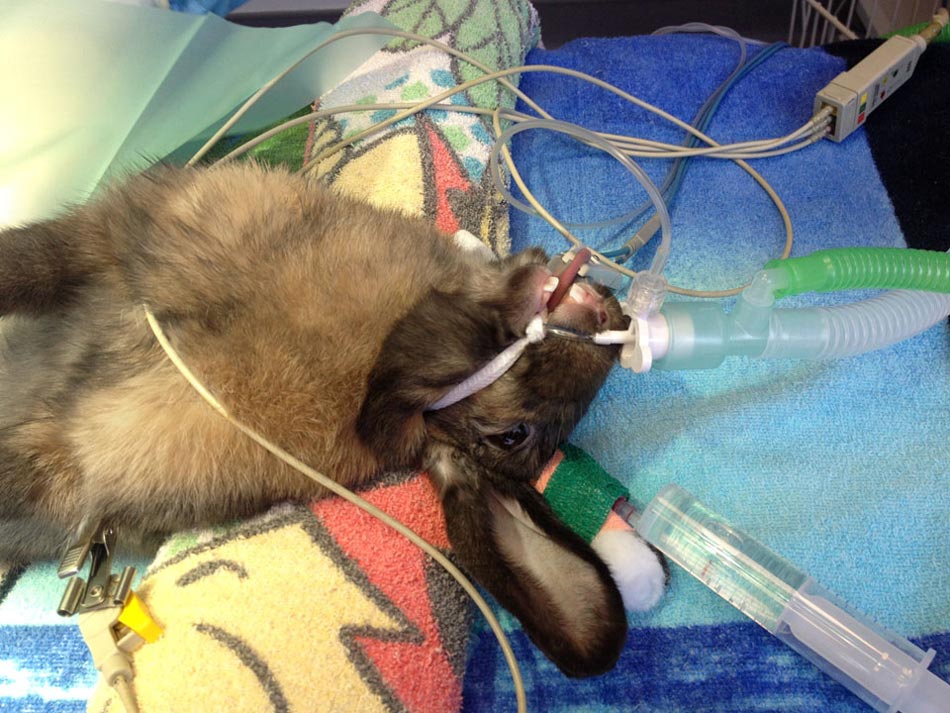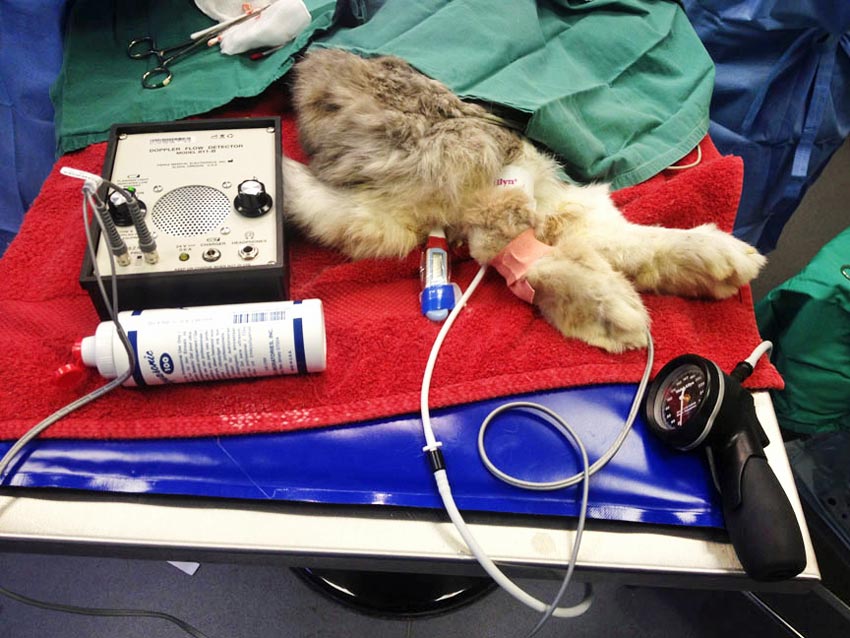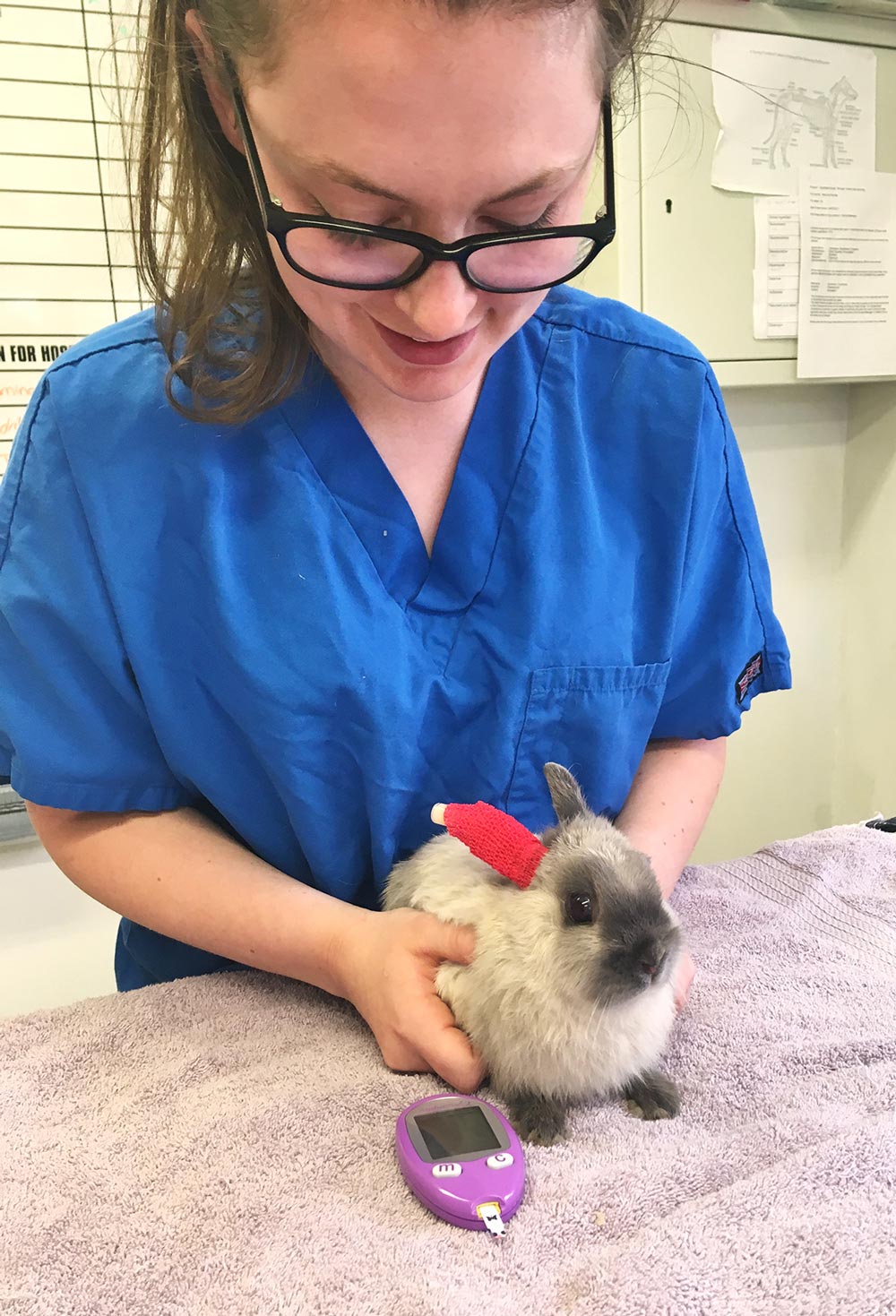21 Nov 2017
Rabbit triage and critical care
An often poorly understood and cared for species, Matthew Rendle spotlights the key steps VNs and vets can take to help when presented with a rabbit in need of urgent help…

IMAGE: onkelramirez1/Pixabay.
Rabbits have been kept as pets for decades and are the third most popular after dogs and cats (Robertson-Smith et al, 2010) – yet their veterinary care is often suboptimal.
This is often due to a lack of experience and knowledge about the species from all the veterinary team, which we need to continue to address as a profession.
Not the norm
Rabbit behaviour has been extensively studied. They often display all the behavioural traits that define them as prey species, which makes their veterinary care very different to the two predators most of us share our homes with.
For example, rabbits hide disease – the hypothesis being they are often grazing in large groups in the open, hence the position of their eyes. A predator observing these groups would be looking for the easiest meal, as all predators aim to get the most food using the smallest expenditure of energy. Therefore, a rabbit showing signs of illness would likely be identified by a predator, and attacked and eaten first.
This behaviour continues in captive and domestic rabbits (Anne McBride, personal communication), and this – along with many other behaviours – means rabbits owned by even the most observant and diligent families are often critically ill by the time they are brought into practice.
This is often compounded by the fact the symptoms of some common rabbit illnesses, such as dental disease, result in a slow, chronic loss of weight and body condition. This often goes unnoticed by owners until rabbits are wholly debilitated, meaning they often only present when moribund.

These compromised rabbits need a holistic veterinary approach, and precise and measured nursing to give them the best chance of survival.
As with all species, referral to an appropriate veterinary specialist team is often best, and likely to result in the most timely and, hopefully, positive clinical outcome.
However, sometimes this is not possible – and even if referral is possible, it does not negate the need for these cases to be accurately triaged.
This process will also allow the formation of an appropriate critical care nursing plan. Plus, the referral centre will benefit by having a concise, accurate clinical assessment.
Triage considerations
Take a good, complete history
Husbandry information needs obtaining in a non-leading manner, and should include nutritional, housing and social information, and recent changes. Is the rabbit really eating, for example? This is often difficult to determine.
Visual assessment is essential
Before picking up the rabbit, look for signs of pain and make a quantifiable assessment of it using a rabbit grimace scale. Is tachypnoea, dribbling or a wet chin present? What can you smell? Sadly, we all know what a rabbit with myiasis smells like.
In prey species, such as rabbits – and in an ideal world – this visual assessment should be done while not physically standing watching the patient. Instead, the use of CCTV or the video function on a smartphone will allow you to see what the patient does while not in the presence of what it is likely to perceive as a predator. This approach also allows for easy sharing of this clinical footage.
Always examine in a biosecure manner
Several infectious diseases in rabbits need to be considered. This can be managed by not being vectors for disease ourselves and managing fomites hygienically.
How you pick up the rabbit is important
Rabbits should be picked up slowly, gently and quietly. The author finds placing a medium-sized, thin towel over the whole rabbit and scooping it up to do most of the assessment, with its head covered, to be the most successful way.
Special attention needs to be made during the restraint to how you are holding the rabbit, so excessive pressure is not being placed on the thorax. Also, make sure the towel is not in contact with the rabbit’s eyes at any point.
Be a towel snob, too – the one you use needs to be clean, with no debris or predator smells. It should also have no holes, as these can trap a limb or damage the rabbit’s fine, often fragile nails.
While the restraint is taking place, ideally hold the rabbit over an examination table with a solid top covered by a non-slip rubber mat. Also, stay alert – rabbits will often stay very still for a period of time, then have a brief, but often spectacular, attempt to escape the restraint. These explosive escape bids are very common in lots of prey species.
Check weight, hydration and body condition first
By checking the rabbit’s weight, hydration and body condition score first, required drugs and fluids can be prepared under the instruction of the veterinary surgeon while the triage continues.
Physical examination
The physical examination can start at either end, but slowly progress and aim to leave the area most unpleasant for the patient until last.
So, if dental disease is suspected, start caudally and work cranially, and vice-versa. You will need to decide this on a case-by-case basis and assess:
- Coat condition – is any matting, wet patches, faecal contamination around its rear end or a wet chin present? These are useful in aiding vets to make a diagnosis and allow a more focused clinical nursing plan.
- Discharge – is any coming from the eyes, nose or genitals? Consider taking samples.
- Swelling – is any of the genitalia or conjunctiva swollen? This can be a sign of myxomatosis, which is highly infectious and often fatal.
Don’t forget basics
Temperature, pulse and respiration (TPR) should never be forgotten or overlooked – they offer a starting point for data to be recorded, allowing easier assessment of progression or deterioration.
While having the clinical discussion to form the nursing plan, it is important to agree the frequency of repeating the TPR. It needs to be assessed on a case-by-case basis – too often and the patient’s welfare will be compromised, but too little and deterioration of the patient may go unnoticed.

Clinical information sharing
Vets and VNs are often are not great at communicating clinical information between each other. This can lead to misunderstandings for the owner – meaning patient care can be compromised.
We can improve communications about patients in two ways.
Leave emotion behind
Rabbits often present in practice when extremely unwell and this happens for many reasons. It is, sadly, often due to conditions caused by poor husbandry and an inappropriate level of general care by uneducated owners.
This can be very upsetting for both nurses and vets, but it is important not to judge the owners or add emotion-based opinions about the owners when cascading clinical information.
Ideally, aim to give the facts and your clinical opinion about the case as it presents, and how best to nurse and improve the welfare of the rabbit. Once the case reaches its conclusion, be it a negative or positive outcome, this could be the time to try to inform and educate owners about how things could be done to prevent the situation from happening again.
Doing this in a professional way is challenging, but will improve rabbit welfare in the long term. While owners need to see they are responsible for their actions, try to get the key points across without appearing like you are reprimanding or punishing them.
In some cases, relaying that owners have had a negative impact on their rabbit’s welfare and quality of life, in a professional and non-judgemental way, may have a bigger impact. It may stop them going out and buying another rabbit that may suffer the same fate.
Use scientific terms if you can
When cascading clinical information, try to avoid as much ambiguity as possible. For example, “it’s breathing fast, skinny and looks rough” should be: “It’s tachypnoeic, with a respiratory rate of 80 breaths per minute and a body condition score of three out of nine. It also has nasal and ocular discharge, and a poor coat quality with some patches of hair loss.”
As proactive VNs, we need to take every opportunity to demonstrate professionalism and show the clinical knowledge we have.

Consider a mnemonic
A few other things should be considered when it comes to rabbits.
The author introduces the FUNLAGOS mnemonic to help:
Fibre
Rabbits are hindgut fermenters, so need high levels of fibre for their gastrointestinal tracts to work optimally. Various high-fibre products are available to supplement rabbit patients.
If the patient is not voluntarily feeding to a level to maintain its weight and body condition, syringe feeding small volumes of one of these high-fibre preparations at least every time the rabbit is handled is, in the author’s opinion, advisable.
Uniformity
As VNs, we need to pay attention to the finer details when critically ill rabbit patients are hospitalised.
The importance of trying to maintain as much normality for these patients should never be underestimated. If they live with another rabbit, for example, bringing that rabbit in for company – unless contraindicated by the type of disease presented – is a good idea and anecdotally, occasionally having company appears to encourage anorexic rabbits to eat.
It is also essential to find out how the rabbit has its water (sipper bottle or water bowl) and food presented. Asking the owners to bring in the food bowl they normally have is a good idea, and consider asking them to bring in some of the food the rabbit is used to eating. Even if it is considered nutritionally suboptimal, it can be transitioned to a better diet over at least a week.
Nail clipping
Rabbit nails are often very fragile. If any are broken while the rabbit is being restrained for treatments or sample collection, this can be very painful.
Plus, the scratches a frightened rabbit can cause a carer can be very painful and may subconsciously make us alter our approach to handling these patients in future.
So, why not quickly clip the nails while doing your first nursing assessment? For the author, this is clearly indicated.
Local anaesthetic
A topical lidocaine-prilocaine cream is the critically ill rabbit’s friend, so, ideally, the use of this should be discussed and agreed by the clinical team and become routine.
The numbing cream appears to allow pain-free cannulation of the marginal ear vein, even in the most nervous rabbits. This needs applying to a well-clipped ear, covered with an occlusive dressing, and given time to work – between 5 and 15 minutes. The author likes to write the time the cream was applied on the outside of the dressing with a marker to ensure the cannulation is not attempted too early.
Access to IV
Having IV access for critically ill cats and dogs has become the norm, and it should be the same for rabbits, as it allows IV fluid therapy and administration of drugs.
Plus, if cannulas bandaged in well, but lightly, are well tolerated, the more frequently we place them and the better we will get at the process.
Cannulation of cephalic veins in larger rabbits is relatively easy, well tolerated and worth considering, again with the use of the lidocaine-prilocaine cream.
Glucose
Taking a blood glucose on admission can give much-needed information.
For example, while hyperglycaemia can be an indication of pain or gastric obstruction in rabbits (Harcourt-Brown, 2007), as well as other things, hypoglycaemia can be an issue in chronically debilitated rabbits, and needs correcting without delay and before any clinical assessment.
Taking a blood glucose with a glucometer is quick and easy, and often can be done with the small volume of blood left in the hub of the cannula stylet after its IV use.
Oscillometric
Taking a “baseline” blood pressure at the start of a treatment plan can be useful for vets to allow them to make a more evidence-based assessment, especially as we know rabbits are good at hiding illness.
Getting a blood pressure in rabbits is not always possible, but trying to take one is non-invasive, pain-free and relatively quick.
Apply the cuff at the beginning of the triage; however, remember one blood pressure number does not really tell us a lot. Instead, repeat the process at each handling episode and look for trends rather than numbers – it is hard to know what is normal in rabbits as they vary so much in size.
Saturation
Latent respiratory disease in rabbits can be an issue, yet we tend to reserve the use of pulse oximetry for anaesthesia. However, it is easily measured in conscious rabbits.
Rabbits are often tachypnoeic, especially while being examined or treated, but it is good clinical information to know if this increase in respiratory rate is due to stress or fear, or whether it could be a reflection of pneumonic disease or dysfunction. Supplementary oxygen may need to be provided.

Conclusion
Rabbits make very rewarding nursing cases; we need to be less fearful of applying some of the well-established critical care nursing techniques we use in cats and dogs to these less-familiar, but increasingly popular, pets.
Give it a go – you will be surprised how much can be achieved.
- Some drugs mentioned in this article are used under the cascade.
References
- The Association of Zoo and Exotic Veterinary Nurses (www.azevn.org).
- Harcourt-Brown FM (2007). Gastric dilation and intestinal obstruction in 76 rabbits, Veterinary Record 161(12): 409-414.
- LagoLearn (www.lagolearn.com).
- Rabbit Welfare Association and Fund (www.rabbitwelfare.co.uk).
- Robertson-Smith G, Robertson D, Hicks B et al (2010). The 2010 RCVS survey of the UK veterinary and veterinary nursing professions, http://bit.ly/2ygMpxd
